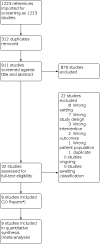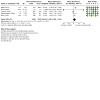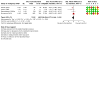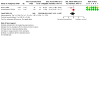Interventions in outside-school hours childcare settings for promoting physical activity amongst schoolchildren aged 4 to 12 years
- PMID: 34694005
- PMCID: PMC8543676
- DOI: 10.1002/14651858.CD013380.pub2
Interventions in outside-school hours childcare settings for promoting physical activity amongst schoolchildren aged 4 to 12 years
Abstract
Background: Insufficient physical activity is one of four primary risk factors for non-communicable diseases such as stroke, heart disease, type 2 diabetes, cancer and chronic lung disease. As few as one in five children aged 5 to 17 years have the physical activity recommended for health benefits. The outside-school hours period contributes around 30% of children's daily physical activity and presents a key opportunity for children to increase their physical activity. Testing the effects of interventions in outside-school hours childcare settings is required to assess the potential to increase physical activity and reduce disease burden.
Objectives: To assess the effectiveness, cost-effectiveness and associated adverse events of interventions designed to increase physical activity in children aged 4 to 12 years in outside-school hours childcare settings.
Search methods: We searched CENTRAL, MEDLINE, Embase, ERIC and SportsDISCUS to identify eligible trials on 18 August 2020. We searched two databases, three trial registries, reference lists of included trials and handsearched two physical activity journals in August 2020. We contacted first and senior authors on articles identified for inclusion for ongoing or unpublished potentially relevant trials in August 2020.
Selection criteria: We included randomised controlled trials, including cluster-randomised controlled trials, of any intervention primarily aimed at increasing physical activity in children aged 4 to 12 years in outside-school hours childcare settings compared to usual care. To be eligible, the interventions must have been delivered in the context of an existing outside-school hours childcare setting (i.e. childcare that was available consistently throughout the school week/year), and not set up in the after-school period for the purpose of research. Two review authors independently screened titles and abstracts of identified papers with discrepancies resolved via a consensus discussion. A third review author was not required to resolve disagreements.
Data collection and analysis: Two review authors independently extracted data and assessed the risk of bias of included trials with discrepancies resolved via a consensus discussion; a third review author was not required to resolve disagreements. For continuous measures of physical activity, we reported the mean difference (MD) with 95% confidence intervals (CIs) in random-effects models using the generic inverse variance method for each outcome. For continuous measures, when studies used different scales to measure the same outcome, we used standardised mean differences (SMDs). We conducted assessments of risk of bias of all outcomes and evaluated the certainty of evidence (GRADE approach) using standard Cochrane procedures.
Main results: We included nine trials with 4458 participants. Five trials examined the effectiveness of staff-based interventions to change practice in the outside-school hours childcare setting (e.g. change in programming, activities offered by staff, staff facilitation/training). Two trials examined the effectiveness of staff- and parent-based interventions (e.g. parent newsletters/telephone calls/messages or parent tool-kits in addition to staff-based interventions), one trial assessed staff- and child-based intervention (e.g. children had home activities to emphasise physical activity education learnt during outside-school hours childcare sessions in addition to staff-based interventions) and one trial assessed child-only based intervention (i.e. only children were targeted). We judged two trials as free from high risk of bias across all domains. Of those studies at high risk of bias, it was across domains of randomisation process, missing outcome data and measurement of the outcome. There was low-certainty evidence that physical activity interventions may have little to no effect on total daily moderate-to-vigorous physical activity compared to no intervention (MD 1.7 minutes, 95% CI -0.42 to 3.82; P = 0.12; 6 trials; 3042 children). We were unable to pool data on proportion of the OSHC session spent in moderate-to-vigorous physical activity in a meta-analysis. Both trials showed an increase in proportion of session spent in moderate-to-vigorous physical activity (moderate-certainty evidence) from 4% to 7.3% of session time; however, only one trial was statistically significant. There was low-certainty evidence that physical activity interventions may lead to little to no reduction in body mass index (BMI) as a measure of cardiovascular health, compared to no intervention (SMD -0.17, 95% CI -0.44 to 0.10; P = 0.22; 4 trials, 1684 children). Physical activity interventions that were delivered online were more cost-effective than in person. Combined results suggest that staff-and-parent and staff-and-child-based interventions may lead to a small increase in overall daily physical activity and a small reduction or no difference in BMI. Process evaluation was assessed differently by four of the included studies, with two studies reporting improvements in physical activity practices, one reporting high programme satisfaction and one high programme fidelity. The certainty of the evidence for these outcomes was low to moderate. Finally, there was very low-certainty evidence that physical activity interventions in outside-school hours childcare settings may increase cardiovascular fitness. No trials reported on quality of life or adverse outcomes. Trials reported funding from local government health grants or charitable funds; no trials reported industry funding.
Authors' conclusions: Although the review included nine trials, the evidence for how to increase children's physical activity in outside-school hours care settings remains limited, both in terms of certainty of evidence and magnitude of the effect. Of the types of interventions identified, when assessed using GRADE there was low-certainty evidence that multi-component interventions, with a specific physical activity goal may have a small increase in daily moderate-to-vigorous physical activity and a slight reduction in BMI. There was very low-certainty evidence that interventions increase cardiovascular fitness. By contrast there was moderate-certainty evidence that interventions were effective for increasing proportion of time spent in moderate-to-vigorous physical activity, and online training is cost-effective.
Trial registration: ClinicalTrials.gov NCT01396473 NCT01015599.
Copyright © 2021 The Cochrane Collaboration. Published by John Wiley & Sons, Ltd.
Conflict of interest statement
RV: No interests to declare.
AP: No interests to declare.
LL: No interests to declare.
KB: No interests to declare.
LW is a Co‐ordinating Editor for Cochrane Public Health Group. He has not been involved in the editorial process of this review. He also declares that he is a health promotion manager that is responsible for providing preventive health services to a community in Australia. His team is considering outside of school hours care as a setting for health promotion.
TF: No interests to declare.
MR: MR is an Out of School Hours Care Director for St Pius X School, Windsor Gardens SA, Australia. In addition, she is the South Australian Chairperson for the Out of School Hours Care Association and the South Australian Representative for the National Out of School Hours Care Services Alliance and a member of the Education Standards Board of South Australia.
AO: No interests to declare.
MB: MB is an author on a study (Beets 2015), funded by the National Institutes of Health, included in this review. He was not involved in the study selection, data extraction or risk of bias assessment of any of the included studies.
CM: No interests to declare.
Figures





Update of
References
References to studies included in this review
Annesi 2017 {published data only}
-
- Annesi JJ, Walsh SM, Greenwood BL, Mareno N, Unruh-Rewkowski JL. Effects of the Youth Fit 4 Life physical activity/nutrition protocolon body mass index, fitness and targeted social cognitive theory variables in 9- to 12-year-olds during after-school care. Journal of Paediatrics and Child Health 2017;53:365-73. [DOI: 10.1111/jpc.13447] - DOI - PubMed
Beets 2015 {published data only}
Branscum 2013 {published data only}
-
- Branscum P, Sharma M, Leigh Wang L, Wilson B, Rojas-Guyler L. A true challenge for any superhero: an evaluation of a comic book obesity prevention program. Family and Community Health 2013;36(1):63-76. - PubMed
Brown 2018 {published data only}24274245
Cradock 2016 {published data only}
-
- Cradock AL, Barrett JL, Giles CM, Lee RM, Kenney EL, deBlois ME, et al. Promoting physical activity with the out of school nutrition and physical activity initiative – a cluster-randomized controlled trial. Journal of American Medical Association Pediatrics 2016;170(2):155-62. - PubMed
Dzewaltowski 2010a {published data only}
Economos 2020 {published data only}
Lee 2019 {published data only}
-
- Lee RM, Barrett JL, Daly JG, Mozaffarian RS, Giles CM, Cradock AL, et al. Assessing the effectiveness of training models for national scale-up of an evidence-based nutrition and physical activity intervention: a group randomized trial. BMC Public Health 2019;19:1587. [CLINICAL TRIALS: NCT04009304] [DOI: 10.1186/s12889-019-7902-y] - DOI - PMC - PubMed
Riiser 2020 {published data only}
-
- Riiser K, Richardsen KR, Haugen AL, Lund S, Løndal K. Active play in ASP – a matched-pair cluster-randomized trial investigating the effectiveness of an intervention in after-school programs for supporting children's physical activity. BMC Public Health 2020;20:500. [CLINICAL TRIALS: NCT02954614,] [DOI: 10.1186/s12889-020-08645-1] - DOI - PMC - PubMed
Weaver 2015 {published data only}
References to studies excluded from this review
Beets 2014 {published data only}
Beets 2016a {published data only}
-
- Beets MW, Turner-McGrievy B, Weaver RG, Huberty J, Moore JB, Ward DS, et al. Intervention leads to improvements in the nutrient profile of snacks served in afterschool programs: a group randomized controlled trial. Translational Behavioural Medicine 2016;6(3):329-38. [DOI: 10.1007/s13142-015-0342-z.] - DOI - PMC - PubMed
Beets 2016b {published data only}
Beets 2018 {published data only}
Connor 1986 {published data only}
-
- Connor MK, Smith LG, Fryer A, Erikson S, Fryer S, Drake J. Future fit: a cardiovascular health education and fitness project in an after-school setting. Journal of School Health 1986;56:329-33. - PubMed
Dzewaltowski 2010b {published data only}
Gutin 2008 {published data only}
-
- Gutin B, Yin Z, Johnson M, Barbeau P. Preliminary findings of the effect of a 3-year after-school physical activity intervention on fitness and body fat: the Medical College of Georgia Fitkid Project. International Journal of Pediatric Obesity 2008;3(Suppl 1):3-9. [DOI: 10.1080/17477160801896457] - DOI - PubMed
Iversen 2011 {published data only}
Jago 2014 {published data only}
-
- Jago R, Sebire SJ, Davies B, Wood L, Edwards MJ, Banfield K, et al. Randomised feasibility trial of a teaching assistant led extracurricular physical activity intervention for 9 to 11 year olds: Action 3:30. International Journal of Behavioral Nutrition and Physical Activity 2014;11(1):114. [DOI: 10.1186/s12966-014-0114-z.] - DOI - PMC - PubMed
Jago 2019 {published data only}
-
- Jago R, Tibbitts B, Sanderson E, Bird EL, Porter A, Metcalfe C, et al. Action 3:30R: results of a cluster randomised feasibility study of a revised teaching assistant-led extracurricular physical activity intervention for 8 to 10 year olds. International Journal of Environmental Research & Public Health 2019;16(1):6. [DOI: ] - PMC - PubMed
Kelder 2005 {published data only}
Kenney 2014 {published data only}
Madsen 2013 {published data only}
NCT04213014 {unpublished data only}
-
- NCT04213014. Guys/Girls Opt for Activities for Life Trial (GOAL) to increase young adolescents' physical activity and healthy eating (GOAL). clinicaltrials.gov/ct2/show/NCT04213014 (first received 30 December 2019). [NCT: 04213014]
Nigg 2004 {published and unpublished data}
-
- Nigg C, Battista J, Chang JA, Yamashita M, Chung R. Physical activity outcomes of a pilot intervention using SPARK active recreation in elementary after-school programs. Journal of Sport & Exercise Psychology 2004;26:S144-5.
Salcedo Aguilar 2010 {published data only}
Sharpe 2011 {published data only}
-
- Sharpe EK, Forrester S, Mandigo J. Engaging community providers to create more active after-school environments: results from the Ontario CATCH kids club implementation project. Journal of Physical Activity and Health 2011;8(Suppl 1):S26-31. [PMID: ] - PubMed
Tibbitts 2019 {published data only}
-
- Tibbitts B, Porter A, Sebire SJ, Bird EL, Sanderson E, Metcalfe C, et al. Action 3: 30R: process evaluation of a cluster randomised feasibility study of a revised teaching assistant-led extracurricular physical activity intervention for 8 to 10 year olds. BMC Pediatrics 2019;19(1):1111. [DOI: 10.1186/s12889-019-7347-3] - DOI - PMC - PubMed
Weaver 2016 {published data only}
Wiecha 2012 {published data only}
Yin 2005 {published data only}
-
- Yin Z, Moore JB, Johnson MH, Barbeau P, Cavnar M, Thornburg J, et al. The Medical College of Georgia Fitkid project: the relations between program attendance and changes in outcomes in year 1. International Journal of Obesity 2005;29(Suppl 2):S40-5. [DOI: ] - PubMed
Additional references
ABS 2017
-
- Australian Bureau of Statistics. Childhood education and care Australia. Canberra (ACT): Australian Bureau of Statistics; 2017 June. Report No.:44020DO001_201706.
Afterschool Alliance 2014
-
- Afterschool Alliance. America after 3pm: afterschool programs in demand. Washington (DC): Afterschool Alliance; 2014.
Atkin 2011
-
- Atkin AJ, Gorely T, Biddle SJ, Cavill N, Foster C. Interventions to promote physical activity in young people conducted in the hours immediately after school: a systematic review. International Journal of Behavioural Medicine 2011;18(3):176-87. - PubMed
Aubert 2018
-
- Aubert S, Barnes JD, Abdeta C, Abi Nader P, Adeniyi AF, Aguilar-Farias N, et al. Global matrix 3.0 physical activity report card grades for children and youth: results and analysis from 49 countries. Journal of Physical Activity and Health 2018;15(Suppl 2):251-73. - PubMed
Baranowski 2003
-
- Baranowski T, Baranowski JC, Cullen KW, Thompson DI, Nicklas T, Zakeri IF, et al. The fun, food, and fitness project (FFFP): the Baylor GEMS pilot study. Ethnicity and Disease 2003;13(Suppl 1):1-30. - PubMed
Barbeau 2007
-
- Barbeau P, Johnson MH, Howe CA, Allison J, Davis CL, Gutin B, et al. Ten months of exercise improved general and visceral adiposity, bone and fitness in black girls. Obesity 2007;15(8):2077-85. - PubMed
Bassett 2015
Beets 2009
-
- Beets MW, Beighle A, Erwin HE, Huberty JL. After-school program impact on physical activity and fitness: a meta-analysis. American Journal of Preventive Medicine 2009;36(6):527-37. - PubMed
Beets 2018
Booth 2015
-
- Booth VM, Rowlands AV, Dollman J. Physical activity temporal trends among children and adolescents. Journal of Science and Medicine in Sport 2015;18(4):418-25. - PubMed
Brazendale 2015
Campbell 2020
Cooper 2015
Covidence 2018 [Computer program]
-
- Veritas Health Innovation Covidence. Version accessed January 2018. Melbourne, Australia: Veritas Health Innovation, 2018. Available at covidence.org.
D'Souza 2020
-
- D'Souza NJ, Kuswara K, Zheng M, Leech R, Downing KL, Lioret S, et al. A systematic review of lifestyle patterns and their association with adiposity in children aged 5–12 years. Obesity Reviews 2020;21(e13029):1-12. [DOI: ] - PubMed
Dalene 2018
-
- Dalene KE, Anderssen SA, Andersen LB, Steene‐Johannessen J, Ekelund U, Hansen BH, et al. Secular and longitudinal physical activity changes in population‐based samples of children and adolescents. Scandinavian Journal of Medicine and Science in Sports 2018;28(1):161-71. - PubMed
Ding 2016
-
- Ding D, Lawson KD, Kolbe-Akexader TL, Finkelstein EA, Katzmarzyk PT, Mechelen W, et al. The economic burden of physical inactivity: a global analysis of major non-communicable diseases. Lancet 2016;388(10051):1311-24. - PubMed
Dollman 2005
Drenowatz 2010
EndNote [Computer program]
-
- EndNote X9. Boston (MA): Clarivate Analytics, 2018. Available at endnote.com.
GRADEpro GDT 2015 [Computer program]
-
- McMaster University (developed by Evidence Prime) GRADEpro GDT. Version accessed January 2019. Hamilton (ON): McMaster University (developed by Evidence Prime), 2015. Available at gradepro.org.
Guyatt 2013
-
- Guyatt G, Oxman AD, Sultan S, Brozek J, Glasziou P, Alonso-Coello P, et al. GRADE guidelines: 11: making an overall rating of confidence in effect estimates for a single outcome and for all outcomes. Journal of Clinical Epidemiology 2013;66(2):151-7. - PubMed
Harris 2009
Higgins 2020
-
- Higgins JP, Thomas J, Chandler J, Cumpston M, Li T, Page MJ, et al, editor(s). Cochrane Handbook for Systematic Reviews of Interventions version 6.1 (updated September 2020). Available from training.cochrane.org/handbook/archive/v6.1.
Higgins 2020b
-
- Higgins JP, Li T, Deeks JJ. Chapter 6: Choosing effect measures and computing estimates of effect. In: Higgins JP, Thomas J, Chandler J, Cumpston M, Li T, Page MJ, et al, editors(s). Cochrane Handbook for Systematic Reviews of Interventions. 6.1 edition. Chichester (UK): John Wiley & Sons, 2020. [URL: training.cochrane.org/handbook/current/chapter-06#section-6-5]
Jones 2013
-
- Jones RA, Hinkley T, Okely AD, Salmon J. Tracking physical activity and sedentary behavior in childhood: a systematic review. American Journal of Preventive Medicine 2013;44(6):651-8. - PubMed
Mears 2016
-
- Mears R, Jago R. Effectiveness of after-school interventions at increasing moderate-to-vigorous physical activity levels in 5- to 18-year olds: a systematic review and meta-analysis. British Journal of Sports Medicine 2016;50(21):1315-24. - PubMed
Moher 2009
OECD 2016
-
- Organisation for Economic Co-operation and Development – Social policy division. LMF 2.2: Patterns of employment and the distribution of working hours for couples with children. Paris (IDF): Organisation for Economic Co-operation and Development (OECD); OECD Database; 2016. www.oecd.org/els/family/LMF-2-2-Distribution-working-hours-couple-househ... (accessed 10 February 2019).
OECD 2018
-
- Organisation for Economic Co-operation and Development – Social Policy division. PF4.3: Out-of-school-hours care services. www.oecd.org/els/family/PF4-3-Out-of-school-hours-care.pdf (accessed 10 February 2019).
Ontario Ministry of Education 2017
-
- Ontario Ministry of Education. Before-and-after school programs (kindergarten to grade 6) policies and guidelines for school boards. Toronto (ON): Ontario Ministry of Education; 2017 January.
Pate 2009
-
- Pate RR, O'Neill JR. After-school interventions to increase physical activity among youth. British Journal of Sports Medicine 2009;43:14-8. [DOI: ] - PubMed
Reiner 2013
RevMan Web [Computer program]
-
- Nordic Cochrane Centre, The Cochrane Collaboration Review Manager Web (RevMan Web). Copenhagen: Nordic Cochrane Centre, The Cochrane Collaboration, 2019.
Schünemann 2020
-
- Schünemann HJ, Higgins JP, Vist GE, Glasziou P, Eakl EA, Skoetz N, Guyatt GH. Chapter 14: Completing 'Summary of findings' tables and grading the certainty of the evidence. In: Higgins JP, Thomas J, Chandler J, Cumpston M, Li T, Page MJ, et al, editors(s). Cochrane Handbook for Systematic Reviews of Interventions. 6.1 edition. Chichester (UK): John Wiley & Sons, 2020. [URL: https://training.cochrane.org/handbook/current/chapter-14]
Sterdt 2014
-
- Sterdt E, Liersch S, Walter U. Correlates of physical activity of children and adolescents: a systematic review of reviews. Health Education Journal 2014;73(1):72-89.
Sterne 2019
Tammelin 2014
-
- Tammelin R, Yang X, Leskinen E, Kankaanpaa A, Hirvensalo M, Tammeline T, et al. Tracking of physical activity from early childhood through youth into adulthood. Medicine and Science in Sports and Exercise 2014;46:955-62. - PubMed
Weintraub 2008
-
- Weintraub DL, Tirumalai EC, Haydel KF, Fujimoto M, Fulton JE, Robinson TN. Team sports for overweight children: the Stanford Sports to Prevent Obesity Randomized Trial (SPORT). Archives of Pediatric and Adolescent Medicine 2008;162(3):232-7. - PubMed
WHO 2018a
-
- World Health Organization. Noncommunicable diseases and their risk factors, 2018. www.who.int/ncds/en/ (accessed prior to 9 September 2021).
WHO 2018b
-
- World Health Organization. Non communicable diseases and their risk factors – WHO launches ACTIVE: a toolkit for countries to increase physical activity and reduce non communicable disease, 2018. www.who.int/ncds/prevention/physical-activity/active-toolkit/en/ (accessed prior to 9 September 2021).
WHO 2020
-
- World Health Organization. Physical activity and young people: recommended levels of physical activity for children aged 5–17 years. www.who.int/teams/health-promotion/physical-activity/physical-activity-a... (accessed prior to 9 September 2021).
References to other published versions of this review
Virgara 2019
-
- Virgara R, Maher C, Lewis LK, Phillips A, Wolfenden L, Okely A, et al. Interventions in outside‐school hours childcare settings for promoting physical activity amongst schoolchildren aged 4 to 12 years. Cochrane Database of Systematic Reviews 2019, Issue 7. Art. No: CD013380. [DOI: 10.1002/14651858.CD013380] - DOI - PMC - PubMed
Publication types
MeSH terms
Associated data
LinkOut - more resources
Full Text Sources
Medical
Research Materials

